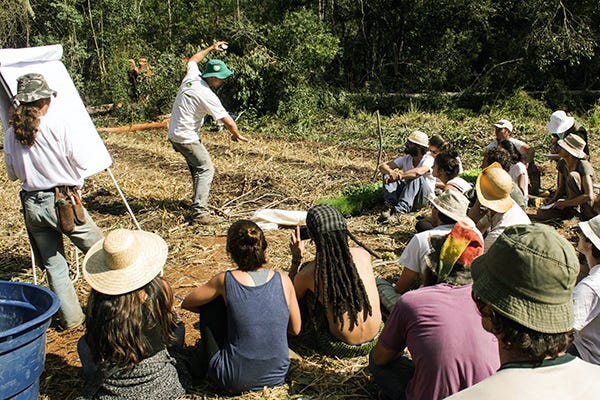The permaculture movement started as a method to create systems based on nature's abundance. Nature thrives on its own without human intervention unless humans have first tampered with it. I recently began a course on an introduction to permaculture because, although I work using systems approaches as a clinician, those approaches focus exclusively on humans and do not include the natural world. I wasn't sure this class would apply to someone like me who doesn't garden or even tend to house plants.
Patrick Whitefield defined permaculture as "the art of designing beneficial relationships." A good operational definition of permaculture is the ecological design that takes nature as a model, meeting human needs while regenerating the world. Inherent in any permaculture design is the primacy of relationships – with people, nonhuman species, and the earth.
Even though permaculture is about more than designing with plants, most people I know and admire who integrate its principles into their lives have close relationships with plants. After I turned 50, it was time to let go of the notion that I would enjoy gardening since I had yet to do that. I spend time in other people's gardens and on their farms, sometimes weeding or helping in different ways. Increasingly, I support local food sources. Rarely does a day go by that I don't spend a day walking at least an hour in nature. Still, would I find my place in a course where the others know more about plants and growing food?
Charles Williams and Starhawk have co-taught the permaculture course for over twenty years through Earth Activist Training. They created it to help people engage at the intersection of permaculture and social activism. Folks involved in permaculture know a lot about solving problems to make systems more harmonious and how to integrate the natural world's wisdom into these systems. However, many need to gain experience changing outside systems that impact the environment. Activists often have experience working to change external systems but lack hands-on experience with regenerating wild and green spaces.
Within the permaculture movement, "social permaculture" is getting more attention, which uses the method of permaculture in human relationships, communities, and social systems. When we come together in a community, our needs, communication styles, goals, and perceptions of steps toward the goals can clash. Differences are natural and can be part of the solution when utilizing healthy relational tools.
Using the first permaculture principle, engaging in a deep observational process, and making no permanent changes, we can discover what we can agree on and ways to facilitate connection, leading to unforeseen creative solutions. Using the principle of observation, we are more motivated to understand another person rather than judge or see them as an impediment to our goal.
Communities and organizations can also prioritize the principle of observation over time to make themselves healthier and more flexible. For example, when we study nature, we understand that it thrives in diversity. Then, we see diversity as a slow but necessary and life-enhancing quality rather than something we "should do" or that we resist. The principle of diversity in nature also calls for us to turn away from monocrop agriculture and its chemicals, destroying the soil for future generations.
My hesitancy that I'd be a class outlier regarding lived experience was unwarranted. In breakout rooms, we introduced ourselves and shared with each other our values, relevant identities, and what brought us to this class.
A couple, a man and a woman, took the class together and noted how they came from very different perspectives, yet held a common hope of what they’d both ultimately take away from the class. The man said that he actively participated in the extraction economy for much of his life and wanted that to change. He felt that his initial attempts at change, like composting with worms and other insects in his home in a Chicago suburb, were relatively small. The woman of the pair, who identified as a witch, had taken a different class with Starhawk and loved it. Her understanding of Gaia (i.e., the Greek goddess that personifies the earth) was abstract, and she wanted it to be more experiential and part of her everyday life. Another woman identified herself as a human healer, working in acupuncture. She aspired to be an earth healer. She shared that her son had been diagnosed with a brain tumor and that they had been on an emotional roller coaster. She had only committed to the class this morning, hoping it could help her focus on positive things that she could do to make things better.
I hoped the course would help make the permaculture principles more alive in my life. I shared that one of the things that most enlivens me is spending time in other cultures, and I've worked for years to have a lifestyle that could incorporate longer trips abroad. But even as I've changed my lifestyle in several essential ways to be more earth friendly, I still need to figure out how to reconcile the disproportionate impact of my traveling with what the planet needs to heal. This class is helping me navigate a path to integrate my values better.
The course's relational style, warm welcome, and how people shared about themselves, including their vulnerabilities, align with permaculture and vibrant community. We can only create life-affirming systems of change when we take time to be relational and support each other's efforts. When we are welcomed where we are at, and welcome others in return, we create the conditions that help us move forward collectively to live our values.







